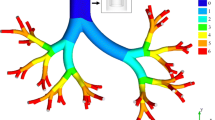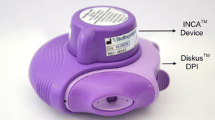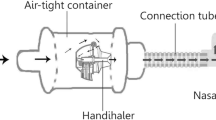Abstract
Purpose. We describe the AERX ™ aerosol delivery system, a new, bolus inhalation device that is actuated at preprogrammed values of inspiratory flow rate and inhaled volume. We report on its in vitro characterization using a particular set of conditions used in pharmacokinetic and scintigraphic studies.
Methods. Multiple doses of aerosol were delivered from single use collapsible plastic containers containing liquid formulation. The aerosol was generated by forcing the formulation under pressure through an array of 2.5 micron holes. Air was drawn through the device at 70 LPM, and the aerosol was collected onto a filter or Andersen cascade impactor. The emitted dose was quantified from the filter collection data, and the particle size distribution was obtained from the best fit log-normal distribution to the impactor data.
Results. 57.0 ± 5.9% of the dose of drug placed as an aqueous solution in the 45 μL collapsible container was delivered as an aerosol (n = 40). The best fit size distribution had an MMAD = (2.95 ± 0.06) μm and a geometric standard deviation σg = 1.24 ± 0.01 (n = 6).
Conclusions. The AERX aerosol delivery system generates a nearly monodisperse aerosol with the properties required for efficient and repeatable drug delivery to the lung.
Similar content being viewed by others
REFERENCES
P. R. Phipps, I. Gonda, S. D. Anderson, D. Bailey, and G. Bautovich. Eur. Respir. J. 7:1474–1482 (1994).
W. Stahlhofen, J. Gebhart, and J. Heyder. Am. Ind. Hyg. Assoc. J. 41:385–390 (1980).
S. P. Newman, A. Hollingworth, and A. R. Clark. International Journal of Pharmaceutics 102:127–132 (1994).
S. J. Farr, A. M. Rowe, R. Rubsamen, and G. Taylor. Thorax 50:639–644 (1995).
E. R. Weibel. Morphometry of the Human Lung. Springer-Verlag, Berlin, 1963.
G. Taylor. Adv. Drug Deliv. Rev. 5:37–61 (1990).
Task Group on Lung Dynamics. Health Phys. 12:173 (1966).
W. C. Hinds. Aerosol Technology. Wiley, New York, 1982.
N. R. Lindblad and H. M. Schneider. J. Sci. Inst. 42:635 (1965).
J. Plateau. Statique Experiemntale et Theorique Liquides soumis aux seules Forces Moleculaires. Gauthier-Villars, Paris, 1873.
J. W. S. Raleigh. Proc. London Math. Soc. 10:4–13 (1878).
E. Tyler, and F. Watkin. Phil. Mag. 14:849 (1932).
N. A. Fuchs. Evaporation and Droplet Growth in Gaseous Media. Pergamon Press, Oxford (1962).
G. A. Ferron, W. G. Kreyling, and B. Haider. J. Aerosol Sci. 19:611–631 (1987).
S. J. Farr, J. A. Schuster, P. M. Lloyd, L. J. Lloyd, J. K. Okikawa, and R. M. Rubsamen. In R. N. Dalby, P. R. Byron, and S. J. Farr (eds.), Respiratory Drug Delivery V, Interpharm Press, Inc., Buffalo Grove, 1996, pp. 175–185.
The United States Pharmacopeia, Rand McNally, Taunton, 1994.
Author information
Authors and Affiliations
Corresponding author
Rights and permissions
About this article
Cite this article
Schuster, J., Rubsamen, R., Lloyd, P. et al. The AERX™ Aerosol Delivery System. Pharm Res 14, 354–357 (1997). https://doi.org/10.1023/A:1012058323754
Issue Date:
DOI: https://doi.org/10.1023/A:1012058323754




